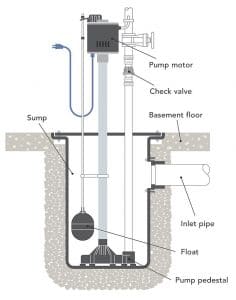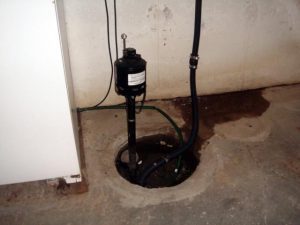Like any other appliance in your home, your pedestal sump pumps need seasonal servicing to make sure you have proper year around issue free performance. A good rule of thumb would certainly be to make sure you examine the operation of one basement sump pump at the very least two times a year; this task just requires a few minutes of your time in order to check the sump pump unit for proper operation.
Your pedestal sump pump is just like one of many things in our homes that we tend to forget about that really does need a certain amount of upkeep from time to time. Unfortunately it’s not until we return home to discover a few inches of standing water in our basements that most of us remember we even have pedestal sump pumps.
For those of you who may not be so familiar with the actual function of a pedestal sump pumps, here is a quick overview for you.

Basement sump pumps are intended remove all the water inside the sump pump basin, which is the bucket like item that the sump pump is lowered into. Once the water reaches up to a specific level, a lever or trigger is tripped which turns your pump on.
Now this of course requires the use of electricity, and / or the use of a battery backup system. The pedestal sump pumps take the built up water from inside the basin and pumps the water out of your basement or crawl space through the use of a discharge pipe that rises out of your sump pump basin. This discharge line then carries the water to the outside of your house and it is pumped away from your home.
Pedestal sump pumps are available in many different styles. A number of these include the submersible sump pump, water powered sump pump, dry sump pump, plus the sump pump battery backup models.
Most plumbing contractors do highly recommend that all homeowners put in sump pump battery backup models.
Pedestal sump pumps with the battery backup might set you back a little more than the average submersible sump pump; however we look at the extra expense as being a real cheap form of insurance. If you think about it, most of the emergency use involving your sump pump usually takes place during adverse weather conditions, which often leads to electric power outages.Several factors you definitely want to keep in mind as you review pedestal sump pumps include:
- The main construction of your sump pumps housing, as well as interior parts. Cast iron housing units definitely will last longer when compared to the standard plastic housing.
- Your inner parts should always be manufactured out of carbon and ceramic as well as assembled using stainless steel screws in order to ensure a nice long working lifespan and to help you prevent corrosion. Cast iron housing sump pumps with carbon and ceramic parts will cost a little extra, but it all gets back to that cheap insurance we spoke about earlier.
- What should be the actual pumping capacity of your submersible or dry sump pump? The greater the pumping capacity, the faster you get rid of the water from the basement. This is usually explained as a GPH number, and this will range from 100gph to 4000gph. If you will have continual need for a heavy duty basement sump pump system, homeowners should look for a double pump pedestal sump pump system. This way in the event that your primary sump pump stops working, your backup pump will kick in. For heavy users, we would also recommend purchasing a ½ horse motor over a 1/6 horse motor.
- Determine if you prefer a submersible pedestal sump pump, a dry sump pump, or possibly even water powered sump pump. If you’re not confident about the model of sump pump you want or will need, this might be a good time for you to consultant with a plumber, or your neighborhood hardware store. A good rule of thumb at this point is just to replace your current pump with the same type that was initially previously installed, but add a new battery backup model, or better yet, the double pump model with a battery backup.

Add pedestal sump pump alarm with your new pump, and you will have the best in protection against water damage. Your basement sump pump alarm system will signal a high water alarm once the water in the basin has reached to a specific level. This unique alarm system will also activate in case you should suffer a sump pump breakdown.
With appropriate installation and regular maintenance of your pedestal sump pump, most people will get plenty of years of issue free operation along with waterless basements. So keep in mind, your basement sump pump is just like every other appliance inside your home and requires upkeep.
Visually check your sump pump at least two times a calendar year. Inspecting for splits around the housing cover, dirt, silt and sediment build up around the motor and the inlets.
Test the operation of your pedestal sump pump simply by pouring a few buckets of water into the pump basin, this way you can be sure your pump activates, and that it is pumping and functioning properly.
Many families rarely spend time down in their basements unless they have them remodeled, which means many of us won’t realize we have any water problems until we walk down into those areas. By that time it really is too late; the water damage has already been done. Of course, this is an excellent reason why you should add a sump pump alarm to your new pedestal sump pumps.



